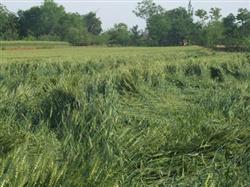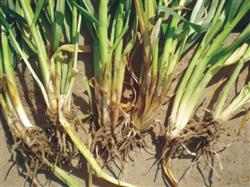Guidance on fertilization Management of Wheat in Spring

In order to implement the national soil testing formula fertilization project and solve the current situation of blind fertilization among farmers, the guiding opinions on wheat fertilization, watering and pest control this spring are put forward for the broad masses of farmers' reference. First, watering from the point of view of water saving, we advocate that wheat should be watered twice in spring, and the normal wheat fields that have been irrigated with frozen water can not be watered back to green water if the soil moisture is good. The spring watering time of wheat should be in the jointing stage (from late March to early April), and the spring water should be in the heading and flowering stage (from late April to early May). The specific watering time depends on the soil moisture of wheat seedlings. For example, if the watering condition is better, you can irrigate three water in dry weather. 2. Fertilization 1. Selection of fertilizer: single nitrogen fertilizer such as urea or ammonium bicarbonate can be applied in low-yield wheat field; nitrogen and potassium topdressing fertilizer specially supplied by soil testing formula fertilizer enterprises is recommended for medium and high yield. The special supply of nitrogen and potassium topdressing is based on the law of fertilizer demand of wheat, paying attention to the proportion of various nutrients and forms of nutrition. The experimental results show that due to the low content of potassium in most soils and the use of single nitrogen fertilizer such as urea ammonium bicarbonate, the root system of wheat is underdeveloped and easy to lodge. The use of special nitrogen and potassium topdressing can promote wheat root development, lodging resistance, enhance wheat drought, cold and disease resistance, increase 1000-grain weight and increase yield. The application of nitrogen and potassium topdressing with the same value can increase the yield by 50-100 kg per mu compared with urea. 2. The proportion and content of nitrogen and potassium topdressing: 30% (25-0-5), 30% (22-0-8), 30% (20-0-10), according to the soil potassium deficiency, choose different potassium content of nitrogen and potassium topdressing. It is recommended to pursue 25-30 kilograms per mu. 3. Fertilization time: ① should promote the management of weak seedling wheat field in spring, apply returning green fertilizer combined with pouring green water, and apply fertilizer for the second time at jointing. ② should promote the combination of control and management measures for general wheat fields in spring. The plots with low soil fertility can be fertilized twice at the jointing stage; for the plots with high soil fertility and strong wheat seedlings, jointing fertilizer should be applied at the jointing stage, preferably after the first Internode of wheat is fixed. The management measures of ③ in spring should be mainly controlled for prosperous and long wheat fields. Fertilization should be applied at the late jointing stage. The amount of topdressing should not be too large so as not to cause the wheat to grow green and mature late. 3. The main diseases of winter wheat are total erosion disease, sheath blight, powdery mildew, rust and cluster dwarf disease, and the main pests are trematode, aphid, red spider and gray planthopper. 1. Wheat powdery mildew and rust can be controlled by spraying 75 grams of 20% fenuoning emulsion 50 ml or 15% vermicellin wettable powder and 70 kg water at the beginning of the disease. 2. Total erosion of wheat can be sprayed with 100 ml of 20% fumarine EC or 150 grams of 15% fumarine wettable powder per mu, and 80 kg of water can be sprayed along the ridge from the emergence stage to jointing stage of wheat. 3. Sheath blight can be sprayed on the base of wheat stem with 5% Jinggangmycin water agent 100ml / mu and 50ml / mu water at the early stage of wheat jointing. 4. To control wheat aphids, 50% aphids can be sprayed with 6 grams of wettable powder per mu and 60 kg of water can be sprayed. 5. To prevent wheat spiders, 1.8% avermectin 3000-4000 times spray per mu can be used to control gray planthopper and prevent cluster dwarf disease. In addition, attention should be paid to strengthening the control of wheat yellow dwarf disease, clump dwarf disease, wheat leaf wasp and underground pests.
- Prev

Occurrence and control of wheat sheath blight in spring
Wheat sheath blight is a kind of fungal disease which is mainly transmitted by soil. With the improvement of the level of yield, the harm of the popularization of high-yield varieties and the management of wheat fields with heavy water and fertilizer is becoming more and more serious. Rhizoctonia solani can infect not only wheat, but also corn, rice, millet, sorghum and so on.
- Next

Factors affecting Maize yield
Factors affecting Maize yield
Related
- The first cup of black tea in spring, the flavor and history of tea gardens in Kenya, Africa
- The computer can not only choose potatoes, but also grow tea rice. AI will grow winter oolong tea champion.
- It is not only the inflated tea bitten by insects, but also engraved with the four seasons tea in Beipu.
- The Oriental Beauty Tea Festival in Zhuxian County takes the stage at the weekend to experience the plus-size feast of oil tea.
- & quot; Oriental Beauty Tea & Exploration of Emei in Hsinchu, the hometown of quot;
- The new variety of strawberry "Tainong 1" dessert is the first choice with mellow aroma. Crimson gorgeous
- History of Tea in Taiwan: from Wild Inner Mountain to Export Tea Garden
- Two types of Taiwan Oriental Beauty Black Tea won the British three-Star Award for Childhood Tea Xiang Zhang Jiaqi changed from pilot to champion tea maker.
- Banana species and varieties: the planting history of Taiwan Xianren banana and dwarf banana is long, is banana disease resistant?
- Coffee planting Technology: Qianjie Coffee from Seedling to harvesting

